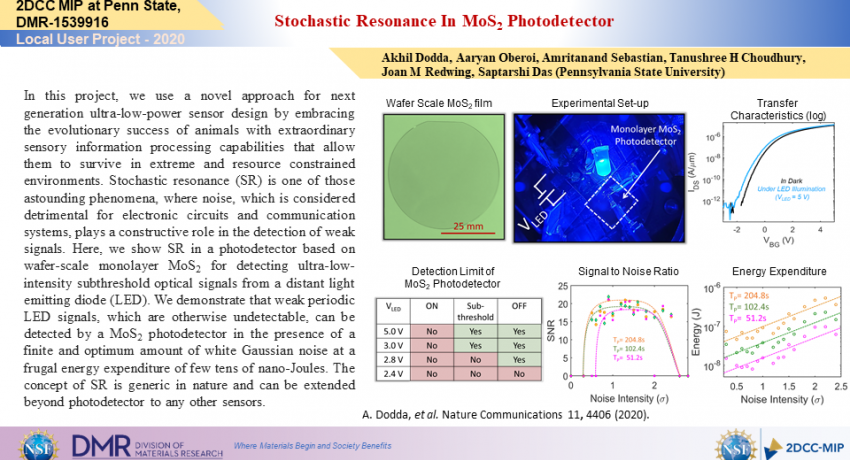What Has Been Achieved:
In this study, we have demonstrated that weak periodic LED signals, which are otherwise undetectable, can be detected by a MoS2 photodetector in the presence of a finite and optimum amount of white Gaussian noise at a frugal energy expenditure.
Importance of the Achievement:
Through this study for the first time we were able to show the constructive role of noise in detecting the low intensity optical signals, which are otherwise not detected, exploiting a phenomenon abundantly found in sensory neurobiology known as stochastic resonance (SR). This research can assist in designing low power sensors for next generation Internet of things (IoT) applications.
Unique Feature(s) of the MIP that Enabled this Achievement:
2DCC-MIP’s MOCVD growth of high-quality, wafer-scale MoS2 films.
The growth of high-quality monolayer MoS2 films enabled us to fabricate high performance photodetectors.
Publication:
Akhil Dodda, Aaryan Oberoi, Amritanand Sebastian, Tanushree Choudhury, Joan M Redwing, Saptarshi Das. Stochastic resonance in MoS2 photodetector. Nature Communications 11, 4406 (2020). https://doi.org/10.1038/s41467-020-18195-0.
Acknowledgements:
The work was partially supported by Army Research Office (ARO) through Contract Number W911NF1920338. Authors also acknowledge the support from the National Science Foundation (NSF) through the Pennsylvania State University 2D Crystal Consortium–Materials Innovation Platform (2DCC-MIP) under NSF cooperative agreement DMR-1539916.
Credits/Names: Akhil Dodda, Aaryan Oberoi, Amritanand Sebastian, Tanushree H Choudhury, Joan M Redwing, Saptarshi Das (Pennsylvania State University)
Download PDF Version: 1539916_2DCCMIP_2020_StochasticResonanceInMoS2Photodetector.pdf
Year of Research Highlight: 2020
Select a Highlight Type: User Highlight
